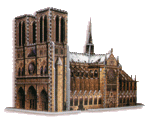Notre Dame

test
The fierce competition for taller churches towering ever closer to the sun was made possible thanks to two new architectural devices: the flying buttresses, used to support the massive exterior wall and which allowed for the inclusion of more translucent walls of stained glass as well as vaulted interiors of unprecedented heights, and rib vaults, for greater elevation of the interior, thus articulating the vertical lines.
Boating a 35 meter vault and several stained-glass and rose windows, Notre Dame de Paris was by far one of the finest representations of the new aesthetic trend spawned by the innovative technique. The style would later be dubbed “Gothic”.
Partially complete in 1245, it construction would span the entire 13th century. The celebrated Viollet-le-Duc began restoration work in 1844. The architect’s most notable achievement was the reinstatement of rib vault’s central pointed transverse arch, the foundation of which he traced to the very frame of the building. Adorned with copper statues and seemingly sky bound, the arch reminds us that despite its opulence and the fact that it is forever anchored to the soil dove which it stands, the cathedral remains steadfast in its will to raise the consciousness of the citizens of the French capital and the 10 million visitors it receives each year.
